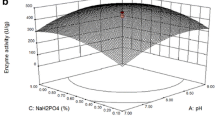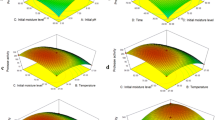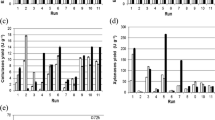Abstract
This study evaluated Streptomyces rochei strain NAM-19 solid-state fermentation of agricultural wastes to produce alkaline protease. Alkaline protease production increased with flaxseed, rice bran, and cheese whey fermentation reaching 147 U/mL at 48 h. Statistical optimization of alkaline protease production was performed using the central composite design (CDD). Results of CDD and the optimization plot showed that 4.59 g/L flaxseed, 4.31 g/L rice bran, 4.17 mL cheese whey, and a vegetative inoculum size of 7.0% increased alkaline protease production by 27.2% reaching 186 U/mL. Using the 20–70% ammonium sulfate fractionation method, the optimally produced enzyme was partially purified to fivefold. The partially purified alkaline protease was then covalently immobilized on a biopolymer carrier, glutaraldehyde-polyethylene-imine-κ-carrageenan (GA-PEI-Carr), with 90% immobilization efficiency. Characterizations revealed that immobilization improved thermostability, reusability, optimum temperature, and sensitivity towards metal ions of the free enzyme. The optimal temperature for free and immobilized enzymes was 40 and 50 °C, respectively. Both enzymes had the same optimum pH of 10. Immobilization increased Km from 19.73 to 26.52 mM and Vmax from 56.7 to 62.5 mmol min−1L−1. The immobilized enzyme retained 35% of its initial activity at 70 °C, while the free enzyme retained only 5%. The immobilized enzyme kept 80% of its initial activity at the 20th cycle. After 7 weeks of storage, the free enzyme lost all its initial activity, whereas the immobilized enzyme retained 50%. The free and immobilized enzymes were able to hydrolyze gelatin, and azo-casein demonstrating different relative activity, 85, 80, 90 and 95%, respectively, compared to casein (100%).












Similar content being viewed by others
Data availability
Data will be made available on request.
References
Abdella MA, Ahmed SA, Hassan ME (2023) Protease immobilization on a novel activated carrier alginate/dextrose beads: improved stability and catalytic activity via covalent binding. Int J Biol Macromol 230:123–139. https://doi.org/10.1016/j.ijbiomac.2023.123139
Adeoye A, Adegbola G, Lateef A (2022) New insights into valorization of agro-industrial wastes for production of citric acid: effects of mutation and optimization–a review. EJOSAT 2(5):102–137
Adetunji AI, Olaniran AO (2023) Biocatalytic profiling of free and immobilized partially purified alkaline protease from an autochthonous Bacillus aryabhattai Ab15-ES. Reactions 4(2):231–245. https://doi.org/10.3390/reactions4020013
Aftab S, Ahmed S, Saeed S, Rasool SA (2006) Screening, isolation and characterization of alkaline protease producing bacteria from soil. Pak J Biol Sci 9(11):2122–2126. https://doi.org/10.3923/pjbs.2006.2122.2126
Aggarwal S, Chakravarty A, Ikram S (2021) A comprehensive review on incredible renewable carriers as promising platforms for enzyme immobilization & thereof strategies. Int J Biol Macromol 167:962–986. https://doi.org/10.1016/j.ijbiomac.2020.11.052
Ahmed SA, Mostafa FA, Ouis MA (2018) Enhancement stability and catalytic activity of immobilized α-amylase using bioactive phospho-silicate glass as a novel inorganic support. Int J Biol Macromol 112:371–382. https://doi.org/10.1016/j.ijbiomac.2018.01.162
Alnoch RC, Alves dos Santos L, Marques de Almeida J, Krieger N, Mateo C (2020) Recent trends in biomaterials for immobilization of lipases for application in non-conventional media. Catalysts 10(6):697. https://doi.org/10.3390/catal10060697
Awad GEA, Ghanem AF, Abdel Wahab WA, Wahba MI (2020) Functionalized κ-carrageenan/hyperbranched poly(amidoamine)for protease immobilization: thermodynamics and stability studies. Int J Biol Macromol 148:1140–1155. https://doi.org/10.1016/j.ijbiomac.2020.01.122
Badoei-Dalfard A, Saeed M, Karami Z (2023) Protease immobilization on activated chitosan/cellulose acetate electrospun nanofibrous polymers: biochemical characterization and efficient protein waste digestion. Biocatal Biotransfor 41(4):279–298. https://doi.org/10.1080/10242422.2022.2056450
Bakhtiar S, Estiveira RJ, Hatti-Kaul R (2005) Substrate specificity of alkaline protease from alkaliphilic feather-degrading Nesterenkonia sp. AL20. Enzyme Microb Technol 37(5):534–540. https://doi.org/10.1016/j.enzmictec.2005.04.003
Bálint B, Bagi Z, Tóth A, Rákhely G, Perei K, Kovács KL (2005) Utilization of keratin-containing biowaste to produce biohydrogen. Appl Microbiol Biotechnol 69:404–410. https://doi.org/10.1007/s00253-005-1993-3
Baş D, Boyacı İH (2007) Modeling and optimization I: usability of response surface methodology. J Food Eng 78(3):836–845. https://doi.org/10.1016/j.jfoodeng.2005.11.024
Borkovec M, Koper GJ (1997) Proton binding characteristics of branched polyelectrolytes. Macromolecules 30(7):2151–2158. https://doi.org/10.1021/ma961312i
Buchanan D, Martindale W, Romeih E, Hebishy E (2023) Recent advances in whey processing and valorisation: technological and environmental perspectives. Int J Dairy Technol 76(2):291–312
De Azeredo L, Freire D, Soares R, Leite S, Coelho R (2004) Production and partial characterization of thermophilic proteases from Streptomyces sp. isolated from Brazilian cerrado soil. Enzyme Microb Technol 34(3–4):354–358. https://doi.org/10.1016/j.enzmictec.2003.11.015
de Cassia Pereira J, Giese EC, de Souza Moretti MM, dos Santos Gomes AC, Perrone OM, Boscolo M, da Silva R, Gomes E, Martins DAB (2017) Effect of metal ions, chemical agents and organic compounds on lignocellulolytic enzymes activities. In: Senturk M (ed) Enzyme inhibitors and activators. In Tech, Croatia, pp 139–164
De Wit J (2001) Lecturer’s handbook on whey and whey products. European Whey Products Association, Brussels
Dias DR, Vilela DM, Silvestre MPC, Schwan RF (2008) Alkaline protease from Bacillus sp. isolated from coffee bean grown on cheese whey. World J Microbiol Biotechnol 24:2027–2034. https://doi.org/10.1007/s11274-008-9706-6
El-Gayar KE, Essa AM, Abada EA (2020) Whey fermentation for protease production using Bacillus thuringiensis Isolated from mangrove rhizosphere soil in Jazan, Saudi Arabia. Pol J Environ Stud 29(3):1–10. https://doi.org/10.15244/pjoes/110583
El Salamony DH, El Gayar DA, El Mahdy AR, Zaghloul TI (2023) Preparation and characterization of silica nanoparticles as an efficient carrier for two bio-detergents based enzymes. J Surfact Deterg 26:577–592. https://doi.org/10.1016/j.biomaterials.2014.12.034
El Salamony DH, Salah Eldin Hassouna M, Zaghloul TI, Moustafa Abdallah H (2024) Valorization of chicken feather waste using recombinant Bacillus subtilis cells by solid-state fermentation for soluble proteins and serine alkaline protease production. Bioresour Technol 393:130110. https://doi.org/10.1016/j.biortech.2023.130110
Elsayed EA, Ahmed Abdelwahed N (2020) Medium optimization by response surface methodology for improved cholesterol oxidase production by a newly isolated streptomyces rochei NAM-19 strain. BioMed Res Int 2020:1870807. https://doi.org/10.1155/2020/1870807
Espoui AH, Larimi SG, Darzi GN (2022) Optimization of protease production process using bran waste using Bacillus licheniformis. Korean J Chem Eng 39(3):674–683
Fatarella E, Spinelli D, Ruzzante M, Pogni R (2014) Nylon 6 film and nanofiber carriers: preparation and laccase immobilization performance. J Mol Catal B Enzym 102:41–47. https://doi.org/10.1016/j.molcatb.2014.01.012
Gervais P, Molin P (2003) The role of water in solid-state fermentation. Biochem Eng J 13(2–3):85–101
Gomaa SK, Zaki RA, Wahba MI, Taleb MA, El-Refai HA, El-Fiky AF, El-Sayed H (2022) Green method for improving performance attributes of wool fibres using immobilized proteolytic thermozyme. 3 Biotech 12(10):254. https://doi.org/10.1007/s13205-022-03323-y
Gupta R, Beg Q, Lorenz P (2002) Bacterial alkaline proteases: molecular approaches and industrial applications. Appl Microbiol Biotechnol 59:15–32. https://doi.org/10.1007/s00253-002-0975-y
Hesketh A, Fink D, Gust B, Rexer HU, Scheel B, Chater K, Wohlleben W, Engels A (2002) The GlnD and GlnK homologues of Streptomyces coelicolor A3 are functionally dissimilar to their nitrogen regulatory system counterparts from enteric bacteria. Mol Microbiol 46:319–330
Hu T-G, Cheng J-H, Zhang B-B, Lou W-Y, Zong M-H (2015) Immobilization of alkaline protease on amino-functionalized magnetic nanoparticles and its efficient use for preparation of oat polypeptides. Ind Eng Chem Res 54(17):4689–4698. https://doi.org/10.1021/ie504691j
Karami Z, Tamri H, Badoei-dalfard A (2022) Immobilization of protease KHB3 onto magnetic metal–organic frameworks and investigation of its biotechnological applications. Catal Lett 152:2256–2269. https://doi.org/10.1007/s10562-021-03808-0
Kumar CG, Takagi H (1999) Microbial alkaline proteases: from a bioindustrial viewpoint. Biotechnol Adv 17(7):561–594. https://doi.org/10.1016/S0734-9750(99)00027-0
Kumari Chitturi CM, Lakshmi V (2016) Development of semi-solid state fermentation of Keratinase and optimization of process by cheaper and alternative agricultural wastes. Development 4(2):1–4
Lakshmi B, Kumar DM, Hemalatha K (2018) Purification and characterization of alkaline protease with novel properties from Bacillus cereus strain S8. J Genet Eng Biotechnol 16(2):295–304. https://doi.org/10.1016/j.jgeb.2018.05.009
Limkar MB, Pawar SV, Rathod VK (2019) Statistical optimization of xylanase and alkaline protease co-production by Bacillus spp using Box-Behnken design under submerged fermentation using wheat bran as a substrate. Biocatal Agric Biotechnol 17:455–464. https://doi.org/10.1016/j.bcab.2018.12.008
Lin S, Zhang X, Wang J, Li T, Wang L (2024) Effect of lactic acid bacteria fermentation on bioactive components of black rice bran (Oryza sativa L.) with different milling fractions. Food Biosci 58:103684. https://doi.org/10.1016/j.fbio.2024.103684
Lineweaver H, Burk D (1934) The determination of enzyme dissociation constants. J Am Chem Soc 56(3):658–666
Liu D, Guo Y, Yolandani MH (2023) Production of value-added peptides from agro-industrial residues by solid-state fermentation with a new thermophilic protease-producing strain. Food Biosci 53:102534. https://doi.org/10.1016/j.fbio.2023.102534
Lorenc F, Jarošová M, Bedrníček J, Smetana P, Bárta J (2022) Structural characterization and functional properties of flaxseed hydrocolloids and their application. Foods 11(15):2304
Lowry OH (1951) Measurement with the folin phenol reagent. J Biol Chem 193:265–275
Marambe HK, Wanasundara JP (2024) Flaxseed (Linum usitatissimum L.) for protein based products. In: Marambe HK, Wanasundara JP (eds) Sustainable protein sources, 2nd edn. Elsevier, pp 339–356
Matrawy AA, Marey HS, Embaby AM (2024) The agro-industrial byproduct wheat bran as an inducer for alkaline protease (ALK-PR23) production by pschyrotolerant Lysinibacillus sphaericus strain AA6 EMCCN3080. Waste Biomass Valori 15:1943–1958
Meena P, Tripathi AD, Srivastava S, Jha A (2013) Utilization of agro-industrial waste (wheat bran) for alkaline protease production by Pseudomonas aeruginosa in SSF using Taguchi (DOE) methodology. Biocatal Agric Biotechnol 2(3):210–216
Mendoza-Cal A, Cuevas-Glory L, Lizama-Uc G, Ortiz-Vázquez E (2010) Naringinase production from filamentous fungi using grapefruit rind in solid state fermentation. Afr J Microbiol Res 4(19):1964–1969
Morilla EA, Stegmann PM, Tubio G (2023) Enzymatic cocktail production by a co-cultivation solid-state fermentation for detergent formulation. Food Bioprod Process 140:110–121. https://doi.org/10.1016/j.fbp.2023.05.001
Mylkie K, Nowak P, Rybczynski P, Ziegler-Borowska M (2021) Polymer-coated magnetite nanoparticles for protein immobilization. Materials 14(2):248
Niyonzima FN, More SS (2015) Purification and characterization of detergent-compatible protease from Aspergillus terreus gr. 3 Biotech 5:61–70
Nouri N, Sadeghi L, Marefat A (2024) Production of alkaline protease by Aspergillus niger in a new combinational paper waste culture medium. J Biosci Bioeng 137(3):173–178. https://doi.org/10.1016/j.jbiosc.2023.12.010
Novelli PK, Barros MM, Fleuri LF (2016) Novel inexpensive fungi proteases: production by solid state fermentation and characterization. Food Chem 198:119–124
Nunes YL, de Menezes FL, de Sousa IG, Cavalcante ALG, Cavalcante FTT, da Silva MK, de Oliveira ALB, Mota GF, da Silva Souza JE, de Aguiar Falcao IR (2021) Chemical and physical Chitosan modification for designing enzymatic industrial biocatalysts: how to choose the best strategy? Int J Biol Macromol 181:1124–1170
Panesar PS, Kennedy JF, Gandhi DN, Bunko K (2007) Bioutilisation of whey for lactic acid production. Food Chem 105(1):1–14
Pant G, Prakash A, Pavani J, Bera S, Deviram G, Kumar A, Panchpuri M, Prasuna RG (2015) Production, optimization and partial purification of protease from Bacillus subtilis. J Taibah Univ Sci 9(1):50–55
Qamar SA, Asgher M, Bilal M (2020) Immobilization of alkaline protease from Bacillus brevis using Ca-alginate entrapment strategy for improved catalytic stability, silver recovery, and dehairing potentialities. Catal Lett 150:3572–3583
Rizzello CG, De Angelis M, Di Cagno R, Camarca A, Silano M, Losito I, De Vincenzi M, De Bari MD, Palmisano F, Maurano F (2007) Highly efficient gluten degradation by lactobacilli and fungal proteases during food processing: new perspectives for celiac disease. Appl Environ Microbiol 73(14):4499–4507
Rodrigues RC, Berenguer-Murcia Á, Carballares D, Morellon-Sterling R, Fernandez-Lafuente R (2021) Stabilization of enzymes via immobilization: multipoint covalent attachment and other stabilization strategies. Biotechnol Adv 52:107821
Roncal T, Maestro B, Prieto-Fernández S (2023) Fermentative production of 2,3-butanediol from cheese whey by a non-engineered mutant strain of Lactococcus lactis. Bioresour Technol Rep 24:101637. https://doi.org/10.1016/j.biteb.2023.101637
Sadaqat B, Sha C, Dar MA, Dhanavade MJ, Sonawane KD, Mohamed H, Shao W, Song Y (2022) Modifying thermostability and reusability of hyperthermophilic mannanase by immobilization on glutaraldehyde cross-linked chitosan beads. Biomolecules 12(7):999
Souza PMd, Bittencourt MLdA, Caprara CC, Freitas Md, Almeida RPCd, Silveira D, Fonseca YM, Ferreira Filho EX, Pessoa Junior A, Magalhães PO (2015) A biotechnology perspective of fungal proteases. Braz J Microbiol 46:337–346
Suo H, Xu L, Xue Y, Qiu X, Huang H, Hu Y (2020) Ionic liquids-modified cellulose coated magnetic nanoparticles for enzyme immobilization: improvement of catalytic performance. Carbohydr Polym 234:115914. https://doi.org/10.1016/j.carbpol.2020.115914
Tan BL, Norhaizan ME, Tan BL, Norhaizan ME (2020) Production of rice by-products. In: Tan BL, Norhaizan ME, Tan BL, Norhaizan ME (eds) Rice by-products: phytochemicals and food products application, 1st edn. Springer, Cham, pp 13–39. https://doi.org/10.1007/978-3-030-46153-9
Tang Y, Wang P, Zeng H, Rui Z (2023) Construction of porous chitosan macrospheres via dual pore-forming strategy as host for alkaline protease immobilization with high activity and stability. Carbohydr Polym 305:120476. https://doi.org/10.1016/j.carbpol.2022.120476
Tsermoula P, Khakimov B, Nielsen JH, Engelsen SB (2021) WHEY-the waste-stream that became more valuable than the food product. Trends Food Sci Technol 118:230–241. https://doi.org/10.1016/j.tifs.2021.08.025
Tsuchida O, Yamagata Y, Ishizuka T, Arai T, Yamada J-I, Takeuchi M, Ichishima E (1986) An alkaline proteinase of an alkalophilic Bacillus sp. Curr Microbiol 14:7–12. https://doi.org/10.1007/BF01568094
Tunga R, Shrivastava B, Banerjee R (2003) Purification and characterization of a protease from solid state cultures of Aspergillus parasiticus. Process Biochem 38(11):1553–1558. https://doi.org/10.1016/S0032-9592(03)00048-7
Virgen-Ortiz JJ, Dos Santos JC, Berenguer-Murcia Á, Barbosa O, Rodrigues RC, Fernandez-Lafuente R (2017) Polyethylenimine: a very useful ionic polymer in the design of immobilized enzyme biocatalysts. J Mater Chem B 5(36):7461–7490. https://doi.org/10.1039/C7TB01639E
VMR (2019) Global Rebaudioside A (Reb A) market market size, status and forecast to 2028. Verified Market Research, New York, NY, USA
Wahba MI (2020a) Calcium pectinate-agar beads as improved carriers for β-d-galactosidase and their thermodynamics investigation. 3 Biotech 10(8):356. https://doi.org/10.1007/s13205-020-02341-y
Wahba MI (2020b) Mechanically stable egg white protein based immobilization carrier for β-D-galactosidase: thermodynamics and application in whey lactose hydrolysis. React Funct Polym 155:104696. https://doi.org/10.1016/j.reactfunctpolym.2020.104696
Wahba MI (2022) Gum tragacanth for immobilization of Bacillus licheniformis protease: optimization, thermodynamics and application. React Funct Polym 179:105366. https://doi.org/10.1016/j.reactfunctpolym.2022.105366
Wahba MI (2023a) Glutaraldehyde-copper gelled chitosan beads: characterization and utilization as covalent immobilizers. Biocatal Agric Biotechnol 50:102668. https://doi.org/10.1016/j.bcab.2023.102668
Wahba MI (2023b) Glutaraldehyde-pea protein grafted polysaccharide matrices for functioning as covalent immobilizers. Sci Rep 13(1):9105. https://doi.org/10.1038/s41598-023-36045-z
Wahba MI, Soliman TN (2018) Whey protein isolate for the preparation of covalent immobilization beads. Biocatal Agric Biotechnol 14:328–337. https://doi.org/10.1016/j.bcab.2018.04.003
Yafetto L (2022) Application of solid-state fermentation by microbial biotechnology for bioprocessing of agro-industrial wastes from 1970 to 2020: a review and bibliometric analysis. Heliyon 8:e09173. https://doi.org/10.1016/j.heliyon.2022.e09173
Yang J-K, Shih L, Tzeng Y-M, Wang S-L (2000) Production and purification of protease from a Bacillus subtilis that can deproteinize crustacean wastes. Enzy Microb Technol 26(5–6):406–413. https://doi.org/10.1016/S0141-0229(99)00164-7
Ye X-P, Xu M-F, Tang Z-X, Chen H-J, Wu D-T, Wang Z-Y, Songzhen Y-X, Hao J, Wu L-M, Shi L-E (2022) Flaxseed protein: extraction, functionalities and applications. Food Sci Technol 42:1–13. https://doi.org/10.1590/fst.22021
Zhang H, Bai Y, Zhu N, Xu J (2021) Microfluidic reactor with immobilized enzyme-from construction to applications: a review. Chin J Chem Eng 30:136–145. https://doi.org/10.1016/j.cjche.2020.12.011
Zhou M-Y, Chen X-L, Zhao H-L, Dang H-Y, Luan X-W, Zhang X-Y, He H-L, Zhou B-C, Zhang Y-Z (2009) Diversity of both the cultivable protease-producing bacteria and their extracellular proteases in the sediments of the South China Sea. Microb Ecol 58:582–590. https://doi.org/10.1007/s00248-009-9506-z
Acknowledgements
The authors would like to thank Chemistry of Natural and Microbial Products Department, Biochemistry Department and Centre of Scientific Excellence-Group of Advanced Materials and Nanotechnology, National Research Center, Dokki, Cairo, Egypt for supporting this work.
Author information
Authors and Affiliations
Corresponding author
Ethics declarations
Conflict of interest
There is no conflict of interest regarding the publication of this paper.
Ethics approval
Ethical approval was not required for this research.
Rights and permissions
Springer Nature or its licensor (e.g. a society or other partner) holds exclusive rights to this article under a publishing agreement with the author(s) or other rightsholder(s); author self-archiving of the accepted manuscript version of this article is solely governed by the terms of such publishing agreement and applicable law.
About this article
Cite this article
El-Shazly, A.I., Wahba, M.I., Abdelwahed, N.A.M. et al. Immobilization of alkaline protease produced by Streptomyces rochei strain NAM-19 in solid state fermentation based on medium optimization using central composite design. 3 Biotech 14, 161 (2024). https://doi.org/10.1007/s13205-024-04003-9
Received:
Accepted:
Published:
DOI: https://doi.org/10.1007/s13205-024-04003-9




